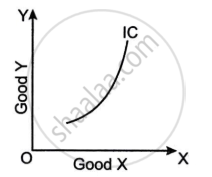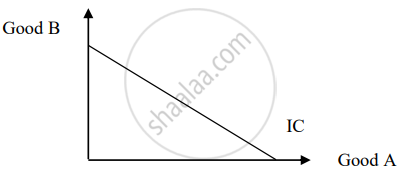Advertisements
Advertisements
Question
What are the properties of indifference curves?
Solution
- The indifference curve must have a negative slope.
- Indifference curves are convex to the origin.
- The indifference curve cannot intersect.
- Indifference curves do not touch the horizontal or vertical axis.
APPEARS IN
RELATED QUESTIONS
Explain the conditions of consumer’s equilibrium using indifference curve analysis.
Define an indifference curve.
Explain why an indifference curve is downward sloping from left to right.
If Marginal Rate of Substitution is constant throughout, the Indifference curve will be :(choose the correct alternative)
a. Parallel to the x-axis.
b. Downward sloping concave.
c. Downward sloping convex.
d. Downward sloping straight line.
Define indifference map.
Explain why is an indifference curve is Convex.
Define an indifference map. Why does indifference curve to the right show more utility? Explain.
Read the following passage and answer the question that follows:
| The ordinal list revolution originates in the criticism of the psychological foundations of the theory of demand, namely, the principle of decreasing marginal utility as Alfred Marshall ([1890] 1898) used it. The rejection of hedonist hypotheses led Irving Fisher (1892) and Pareto (1896-97, 1900, 1909) to favour an objective or "positive" approach to economic concepts. The "ordinal list revolution" (Omarzabal 1995, 116) is grounded in a methodological transformation of economics that put the facts of objective experience as a foundation of economics and provided a research program for the ensuing years (Green and Moss 1993; Lewin 1996). Mathematically, ordinalism is entirely based upon the idea that one can dispense with the use of a specific utility function and that no meaning shall be attached to utility measurement, except as an ordinal principle. Clearly, the development of ordinalism must be separated from the introduction of the concept of the indifference curve. Ordinalism was first advocated in Fisher's "Mathematics Investigations" (1892) and Pareto's Sunto (1900) and Manual ([1909] 1971), while the indifference curve had appeared in F. Y. Edge Worth's Mathematical Psychics (1881). It was thus only through Fisher's and Pareto's recasting that the concept of the indifference curve became irreversibly associated with the promotion of ordinalism. Along the way, the recasting of the theory of choice along ordinal list lines raised a number of issues (about integrability, measurability, and complementarity) that would be progressively settled. The reasonable closing date for the ordinalist revolution is 1950, after Houthakker's (1950) and Samuelson's (1950) contributions. From the late 1920s, the Paretian school was progressively gaining a larger audience while the use of the concept of marginal utility and other derivative concepts was challenged. Consequently, demand theory was recast along with the principles of individual preferences and ordinal utility functions. Nevertheless, English authors proved very silent about the meaning of indifference curves. Most if not all of the reflections after 1920 about the nature of indifference curves took place in America, mainly under the impulse of Henry Schultz at Chicago. This is an American story. |
How is utility measured in Ordinal utility theory?
Assertion (A): A lower indifference curve represents a higher level of satisfaction.
Reason (R): According to the Indifference Curve Approach, utility is an ordinal concept, that is, it can be ranked and not measured.
Which of these is not a property of indifference curve?
"Higher indifference curve represents fewer quantities of one or both goods, a higher indifference curve shows higher utility level." Choose the correct option for the above mentioned statement:
Identify the correct pair of items from the following Columns I and II:
| Column I | Column II |
| (1) Monotonic Preferences | (a) Consumer preferences are called monotonic when between any three bundles, consumers always choose a bundle having more of one good and no less of other goods. |
| (2) Indifference Set | (b) It is a set of those divisions of two goods that offer the consumer the same level of satisfaction so that the consumer is indifferent across any number of combinations in his indifference set. |
| (3) Indifference Curve | (c) It is a curve showing the different combinations of two goods, each combination offering the same level of satisfaction to the consumer. |
| (4) Indifference Map | (d) It refers to a set of indifference curves placed in different diagrams for the same type of goods. |
Which of the following statements are incorrect?
Observe the graph given below and answer the question that follow.

- Give a reason to explain if the graph shown above can be a common phenomenon or not. [2]
- What is an indifference map? Draw its diagram. [2]
- State any two differences between cardinal utility and ordinal utility. [2]
Will you defend or refute the case depicted in the following diagram? Provide a rationale in support of your view.

